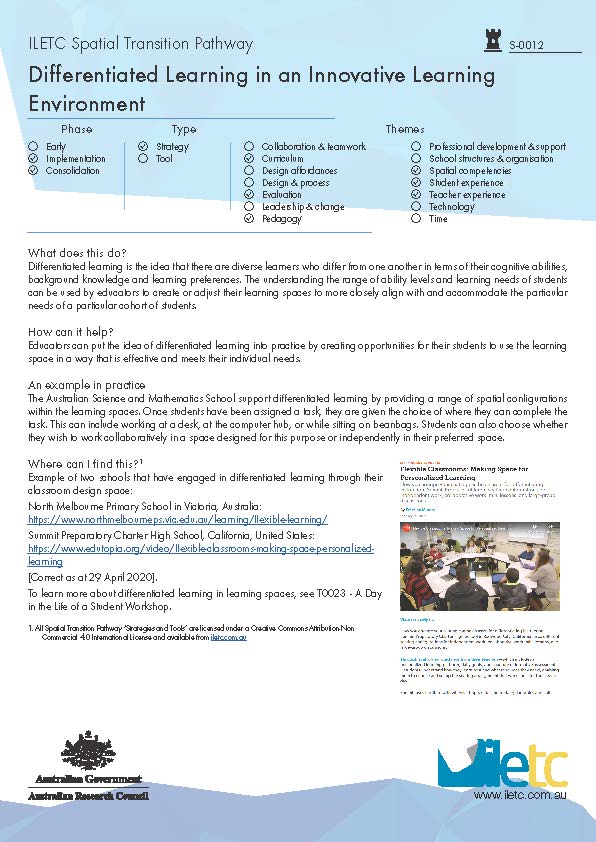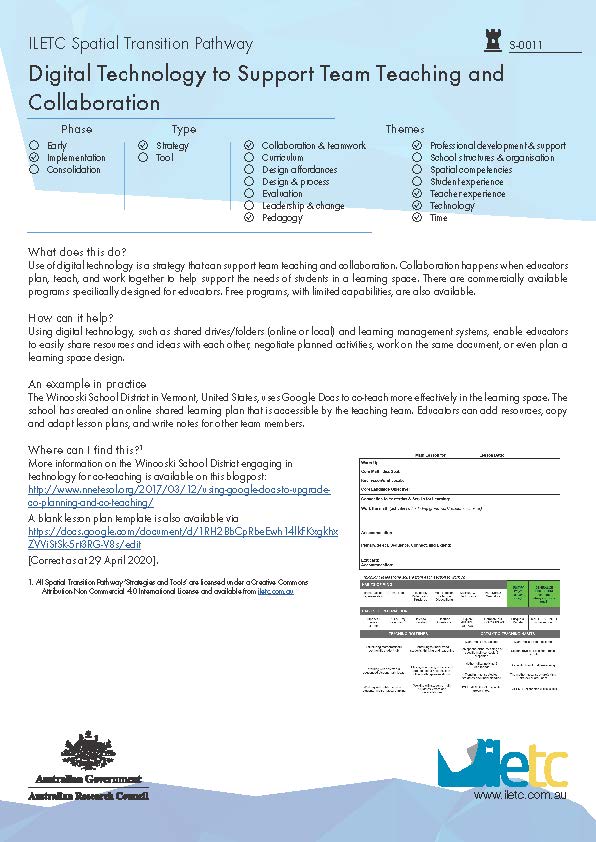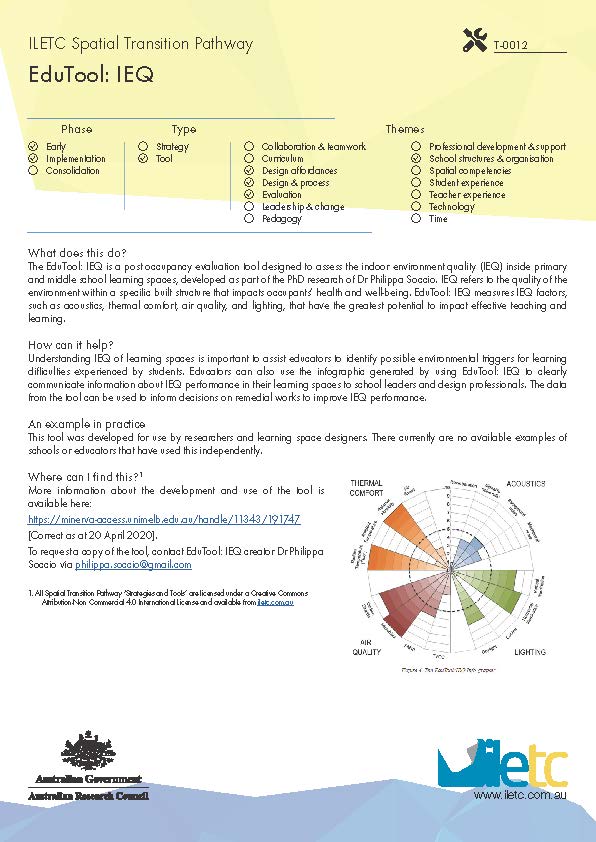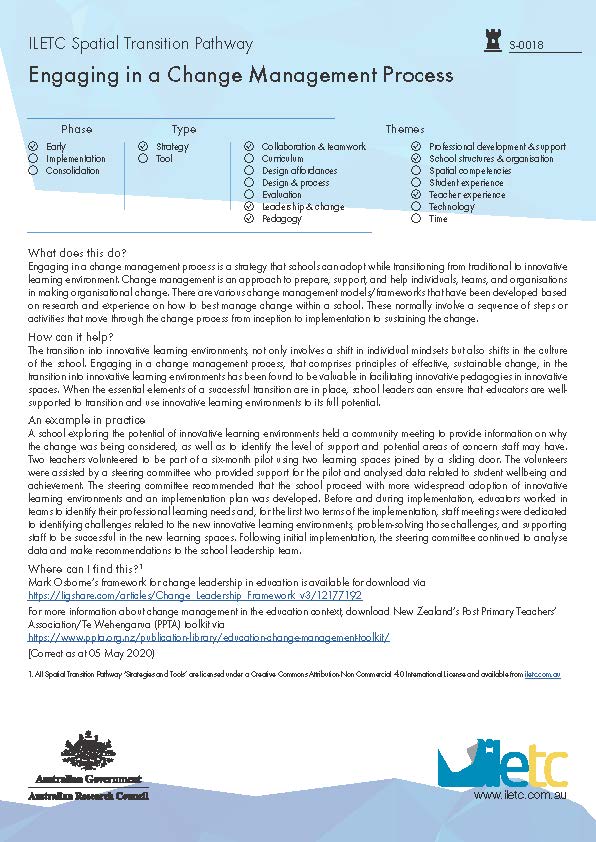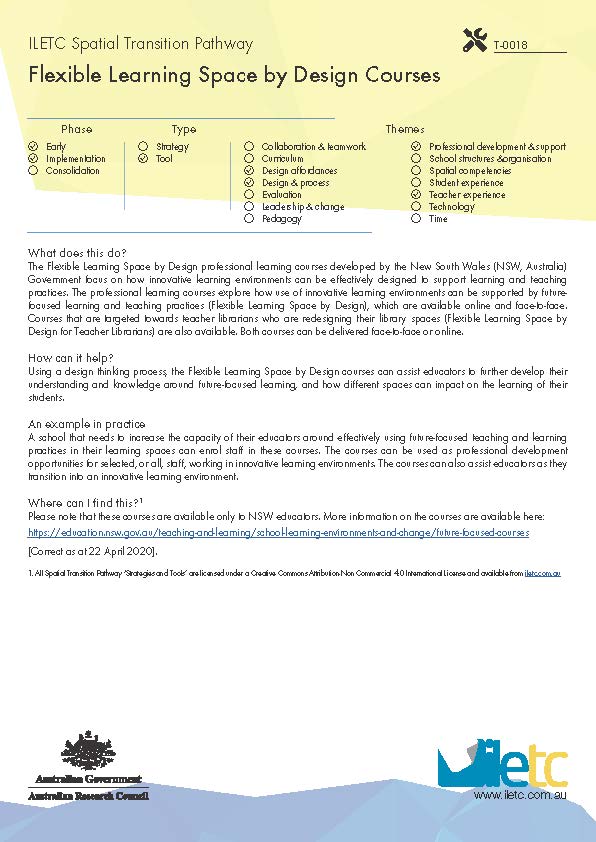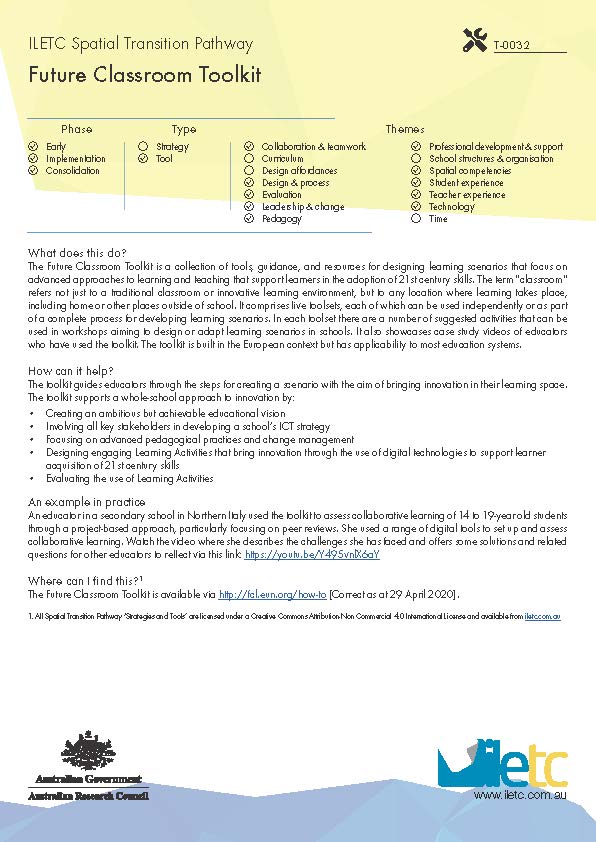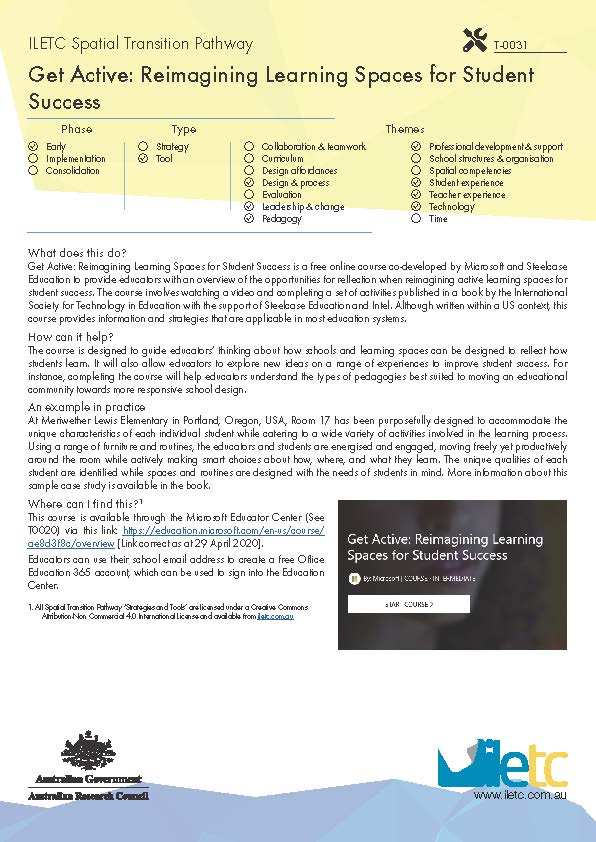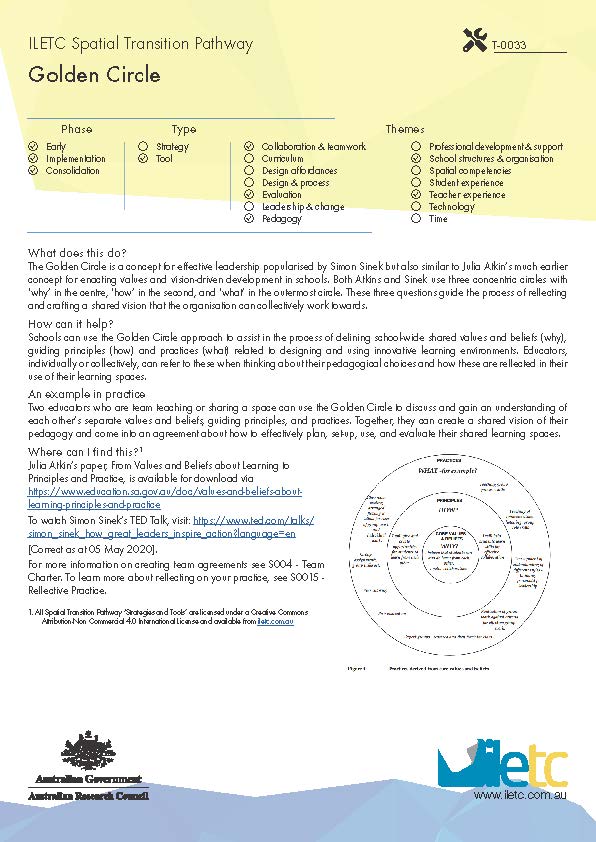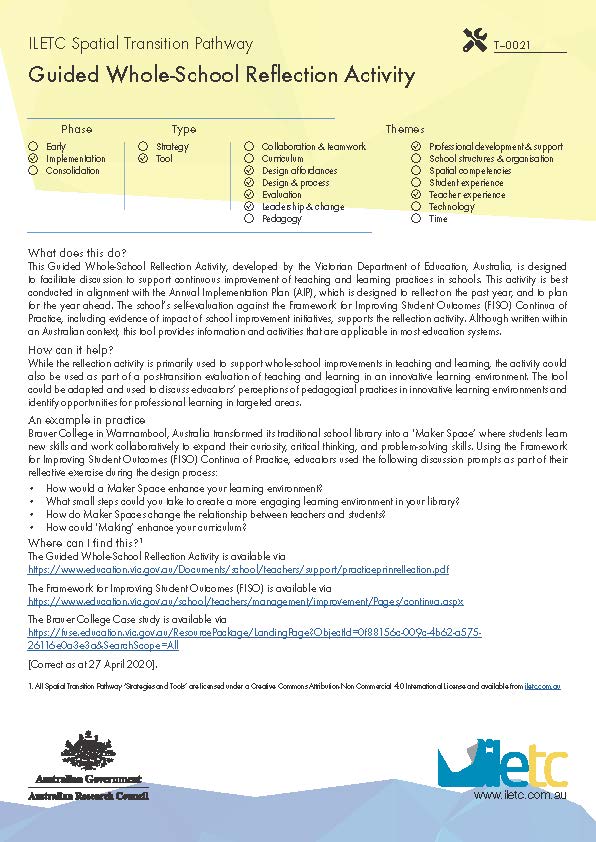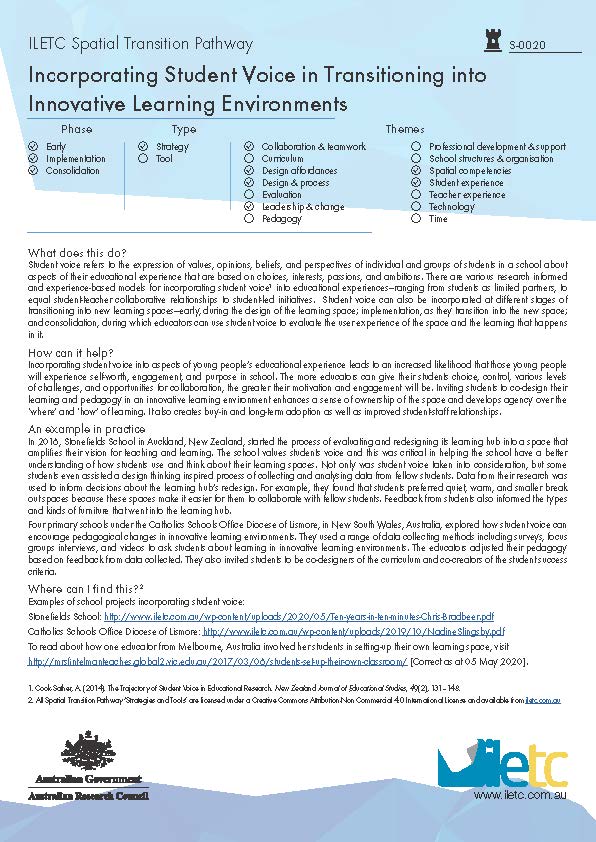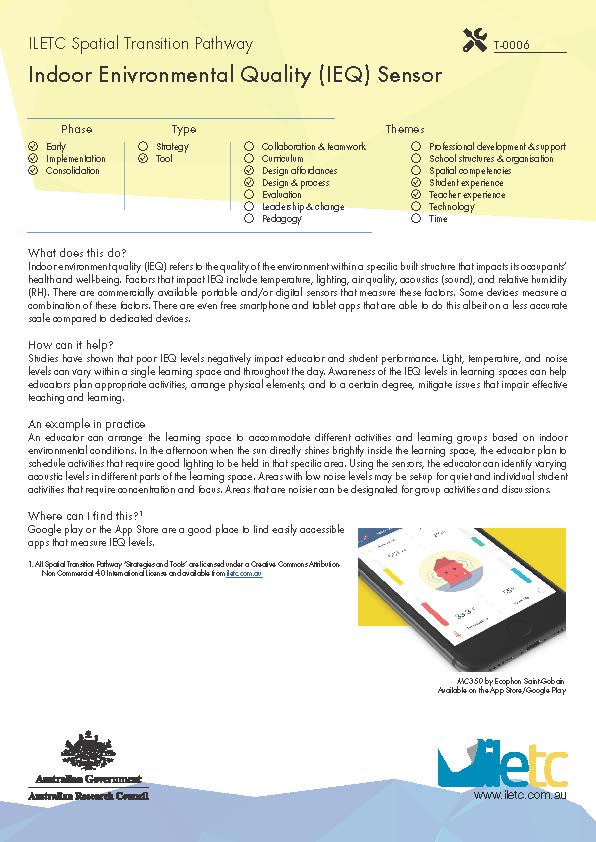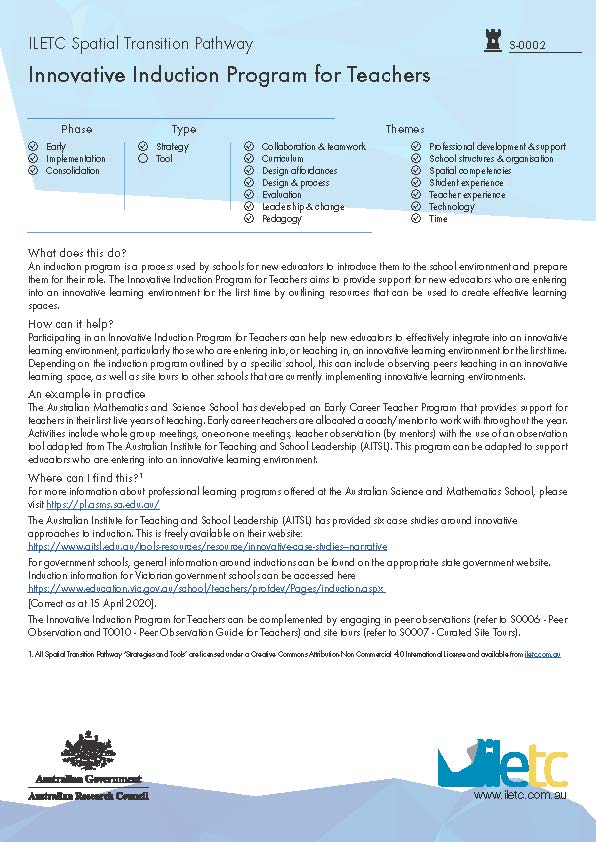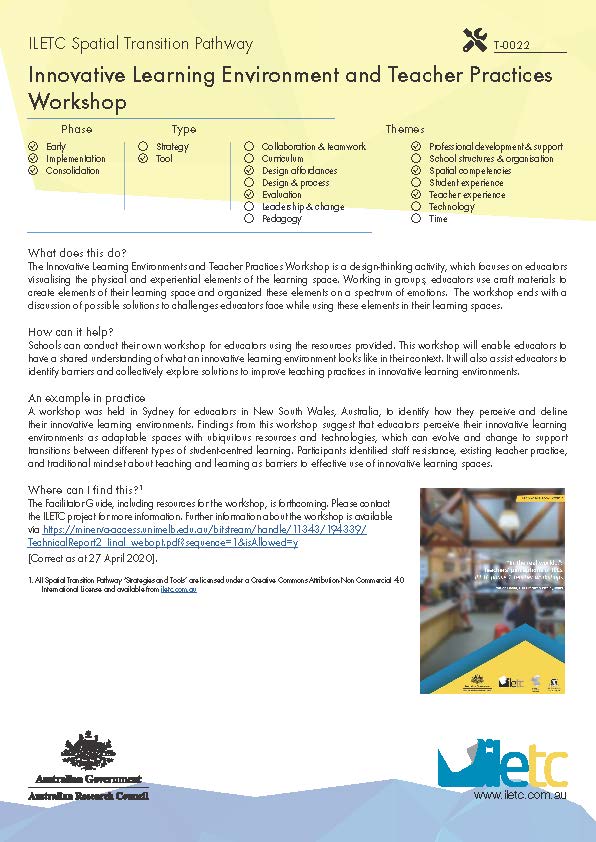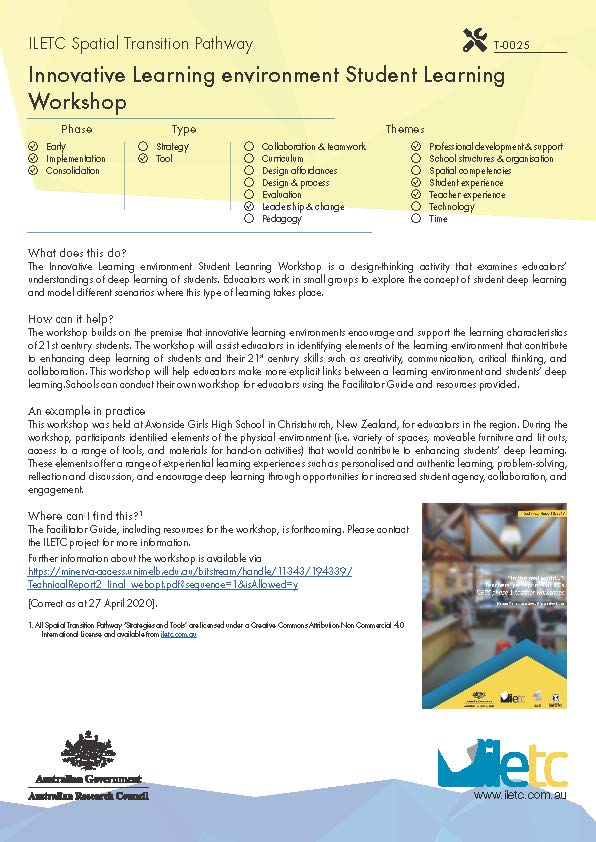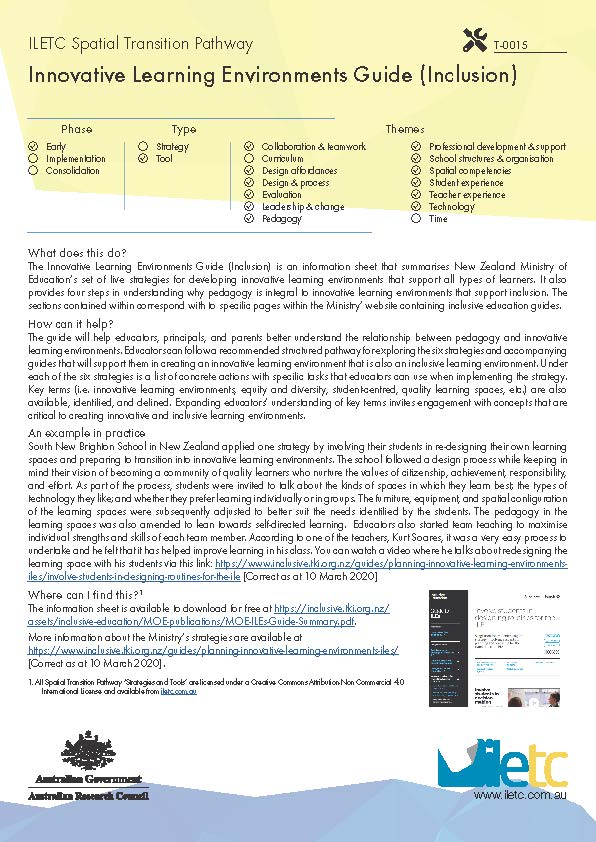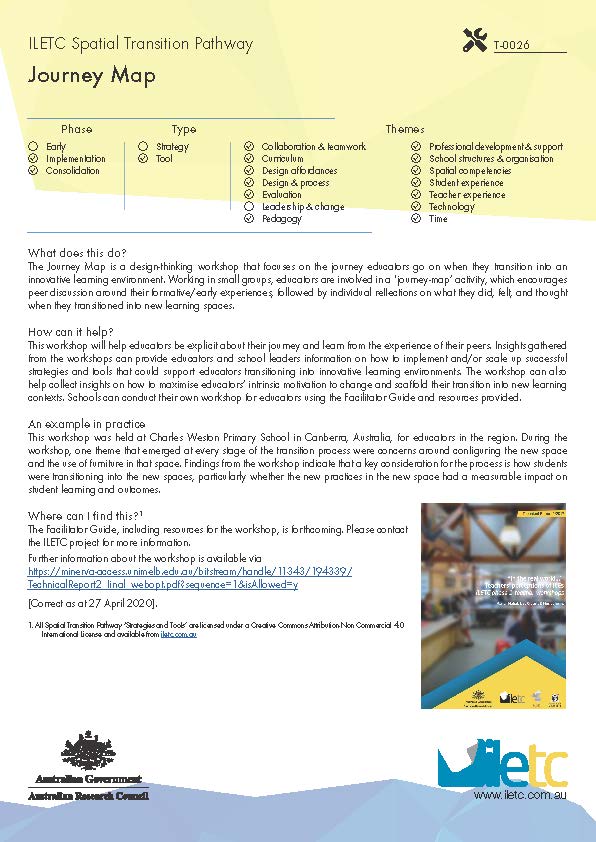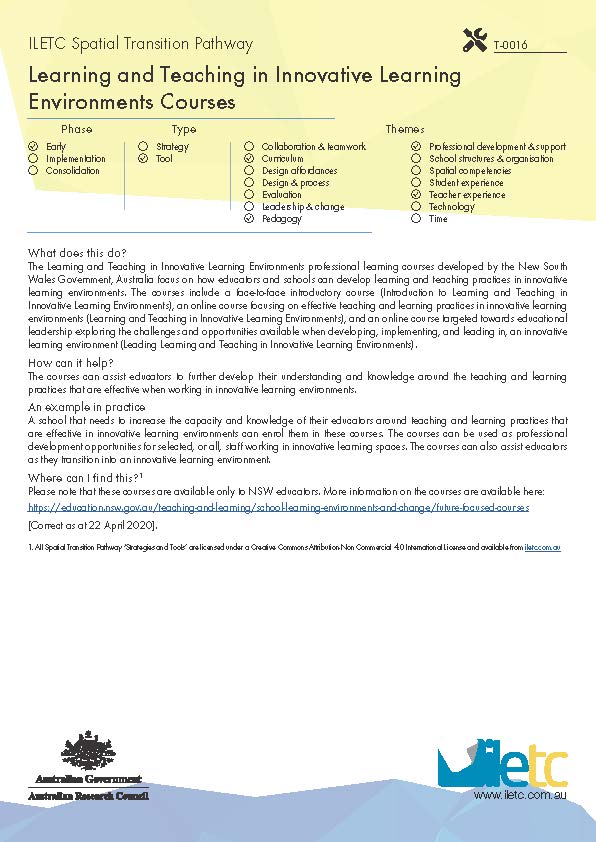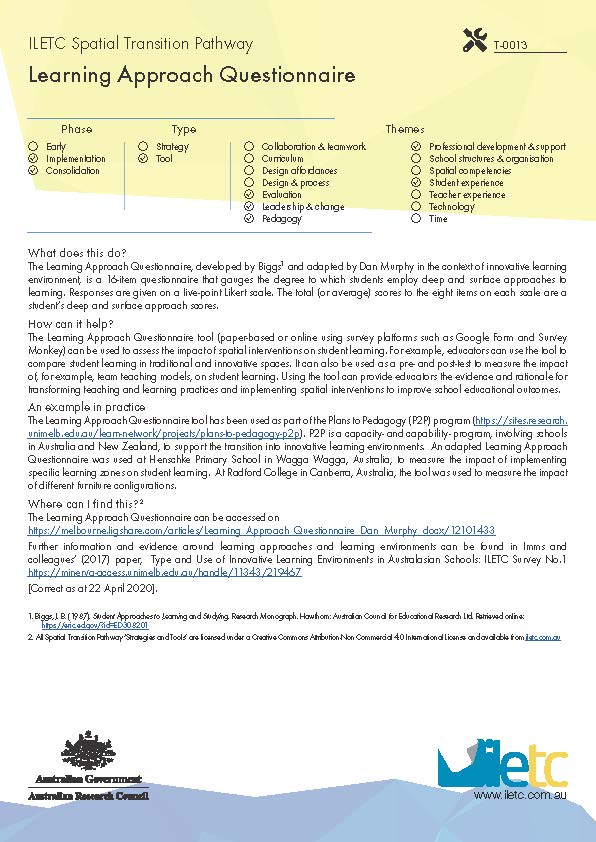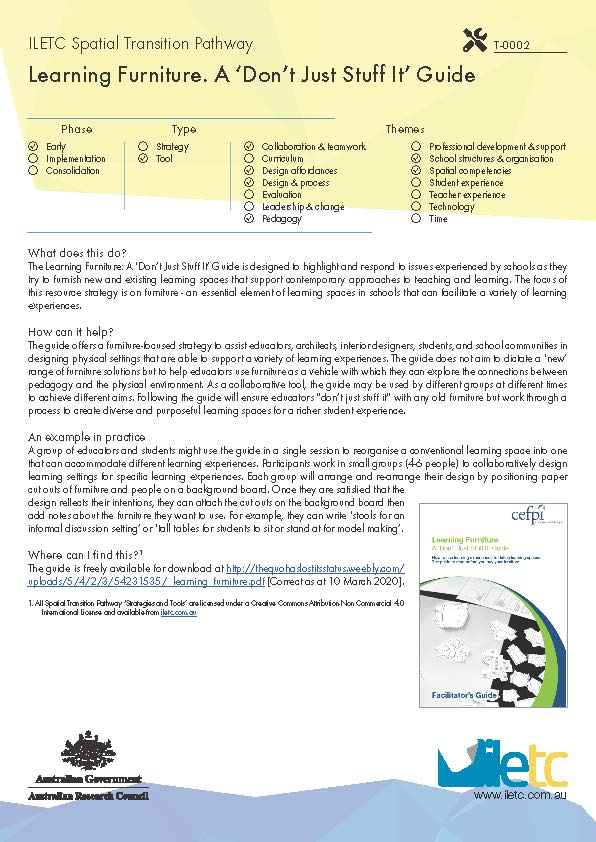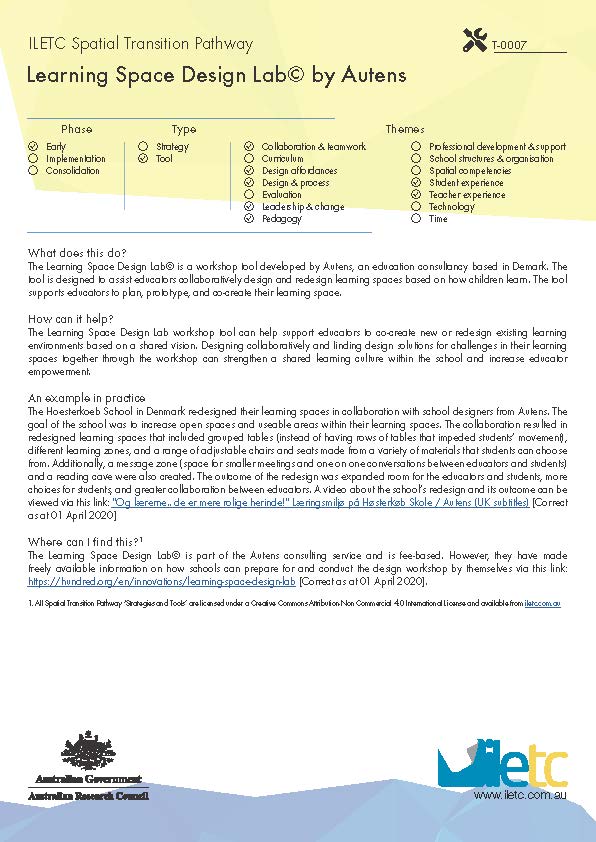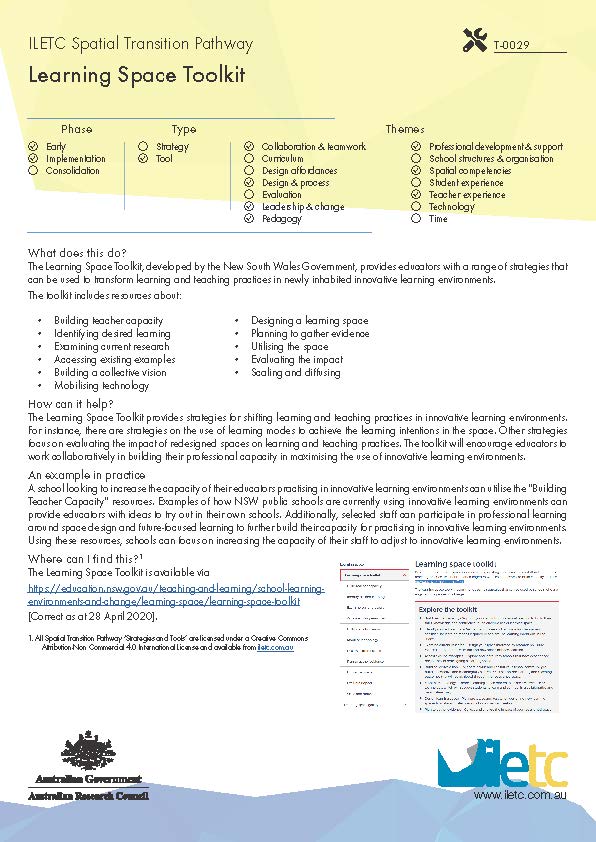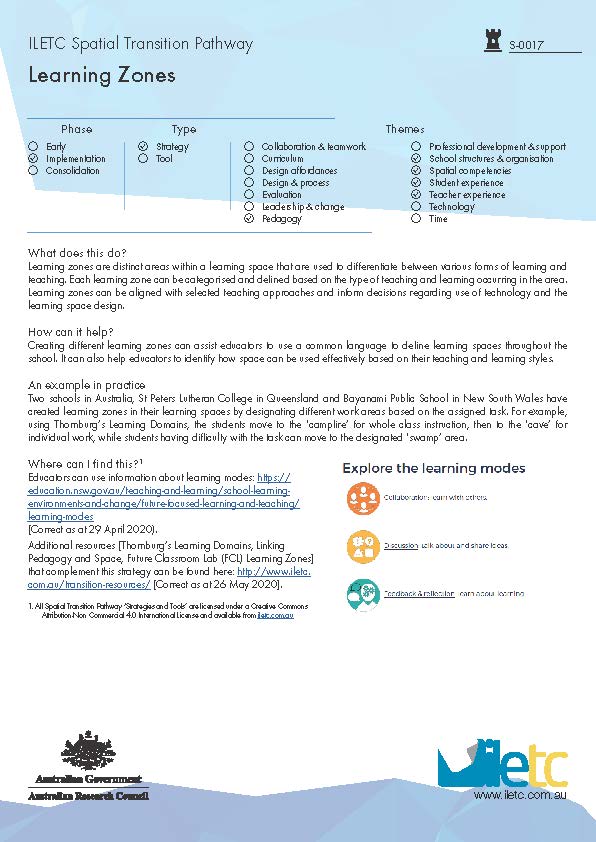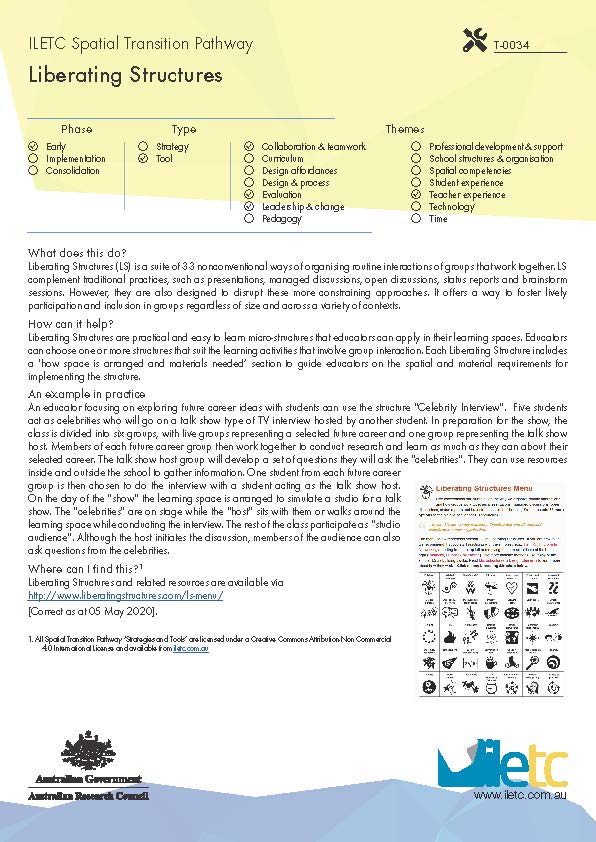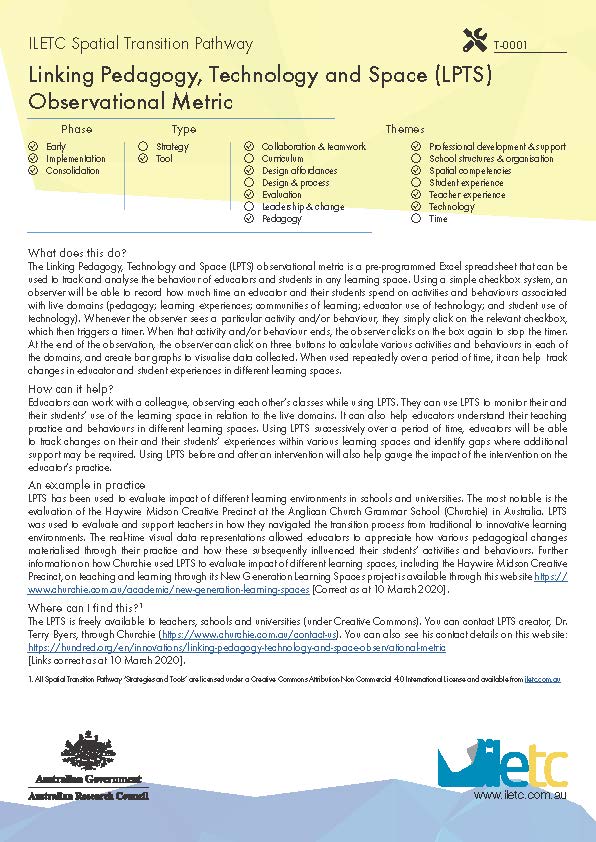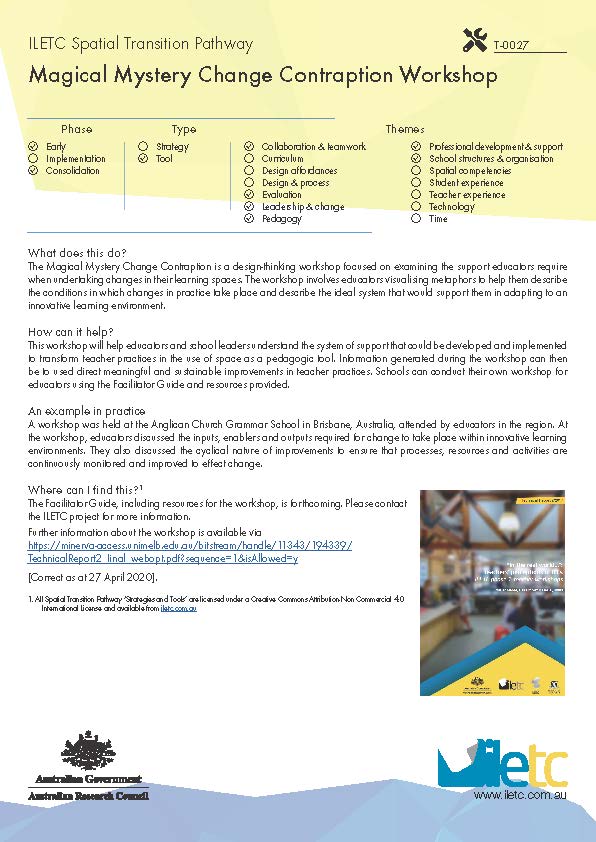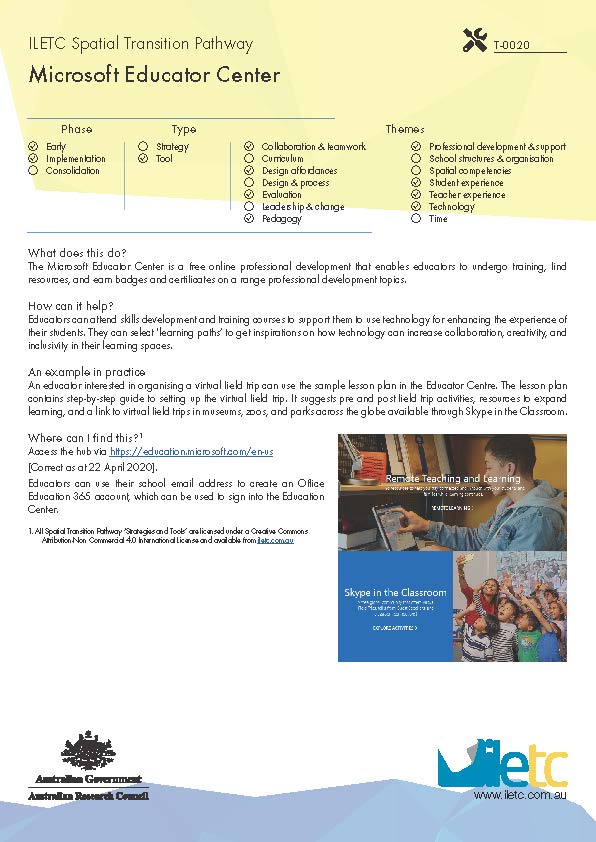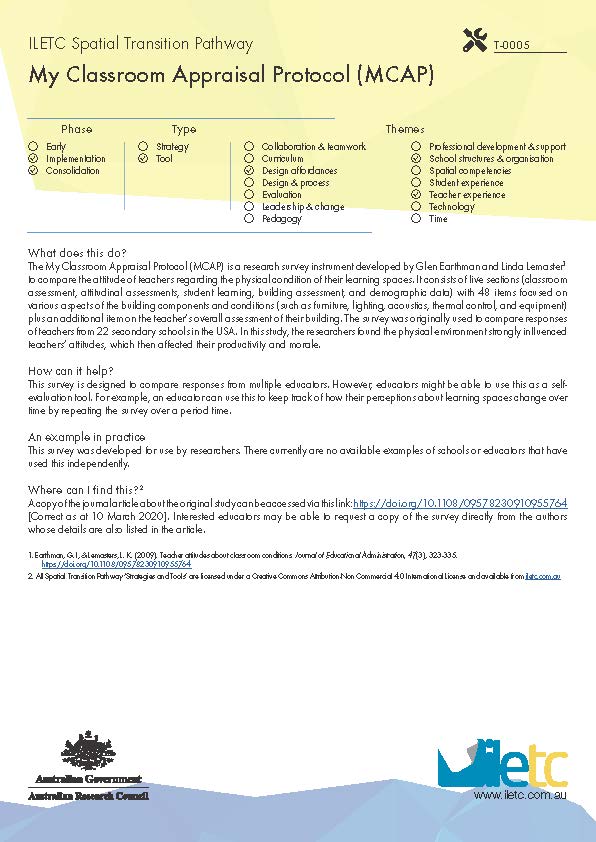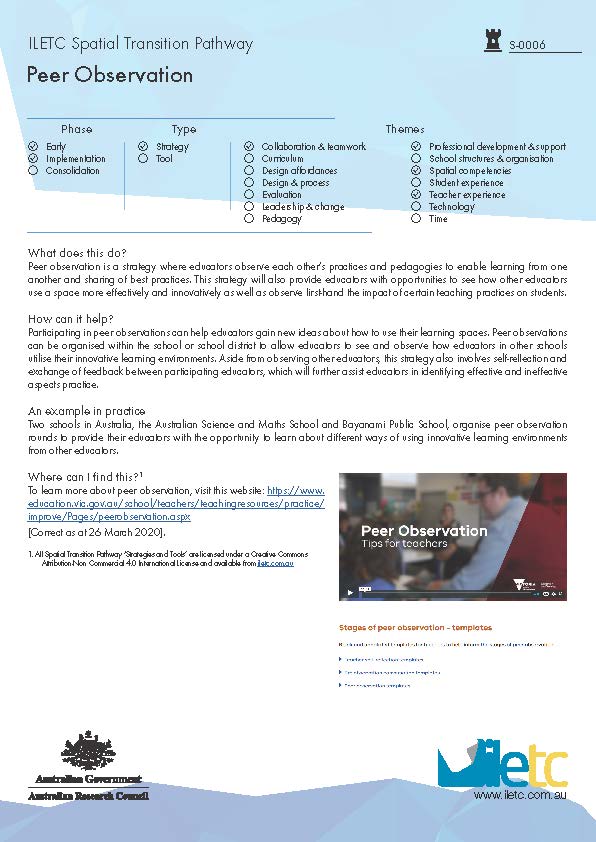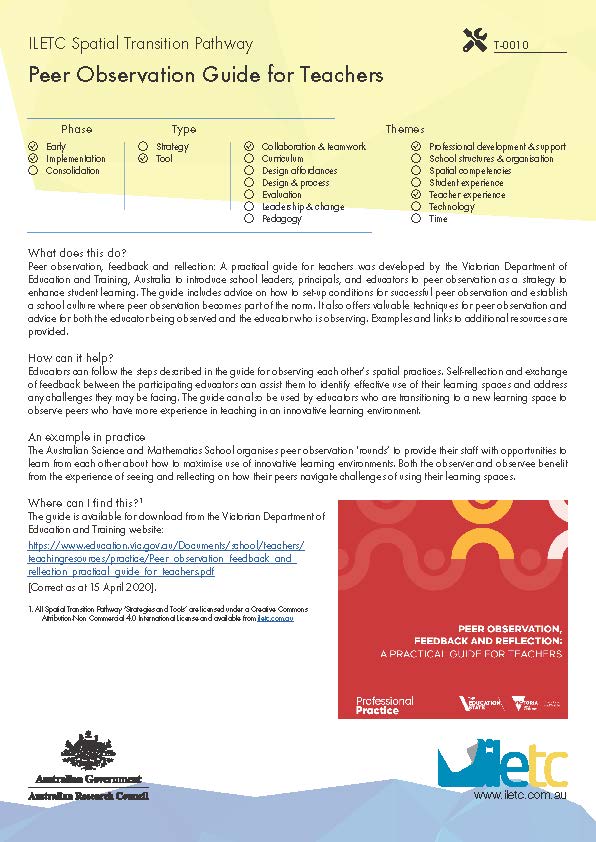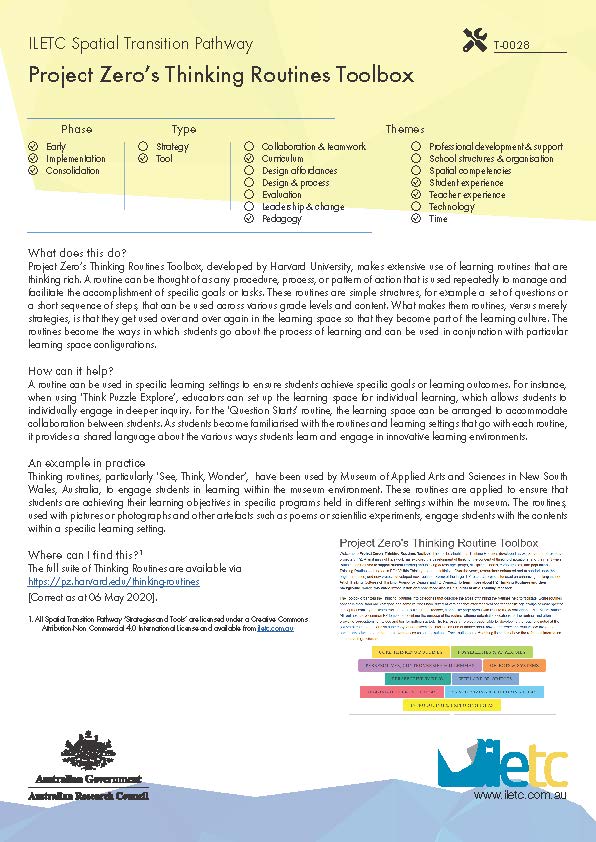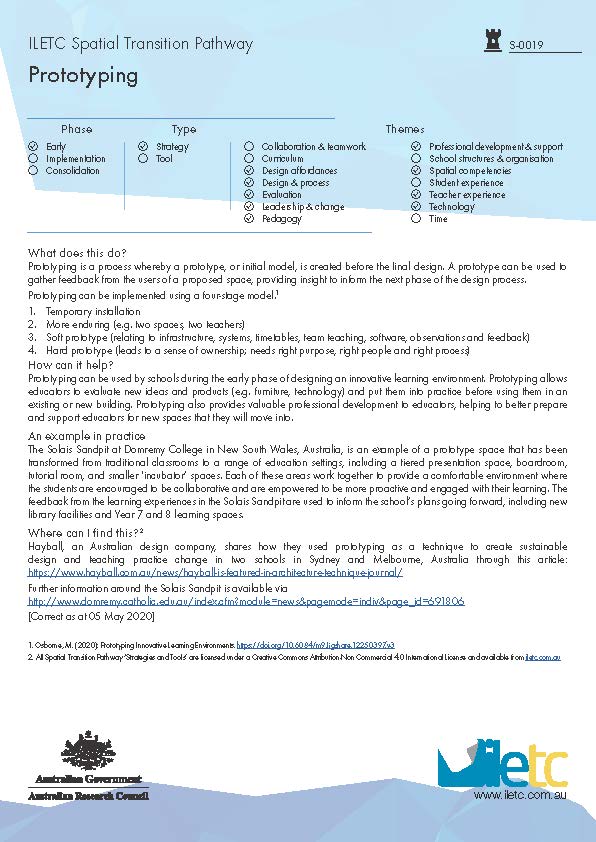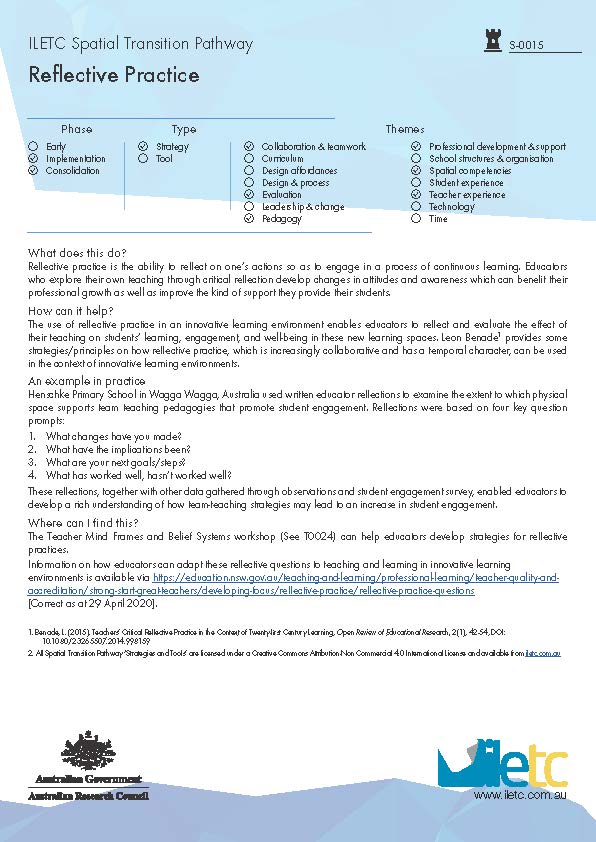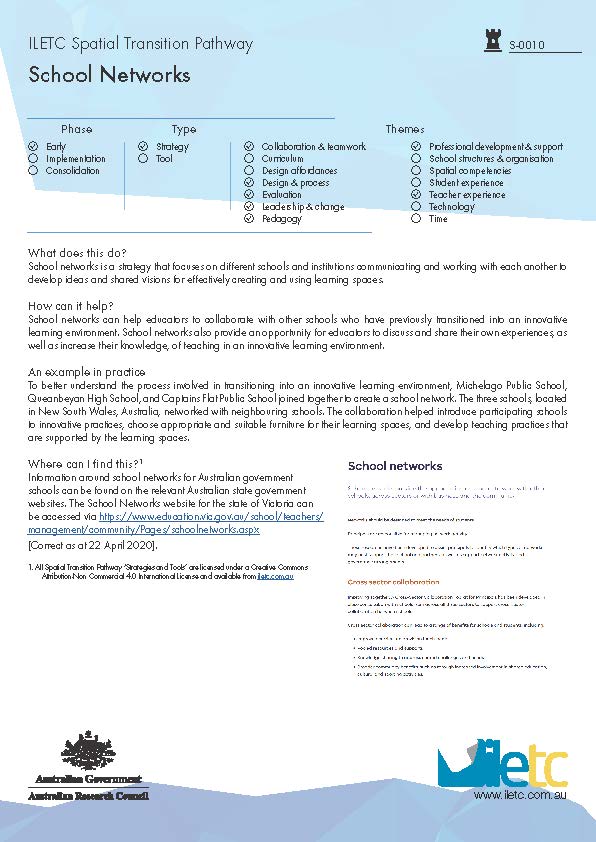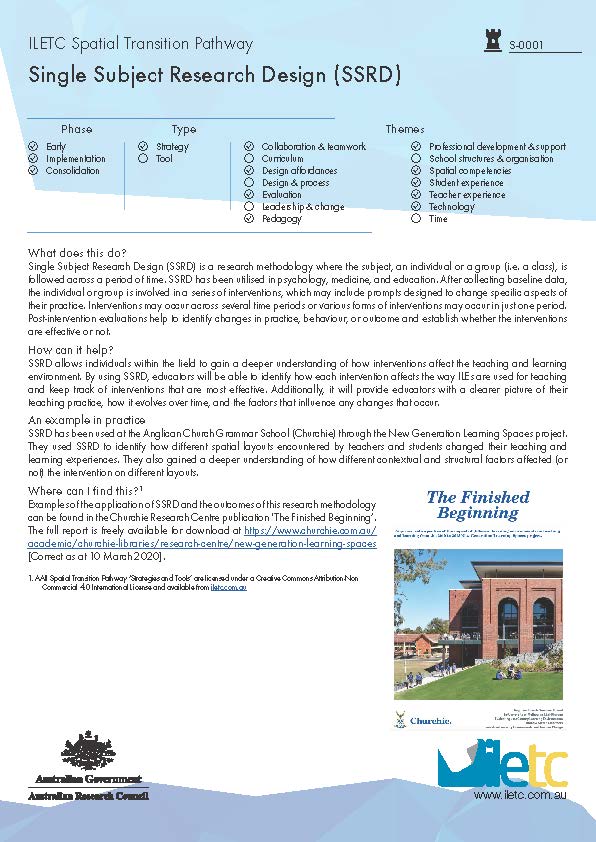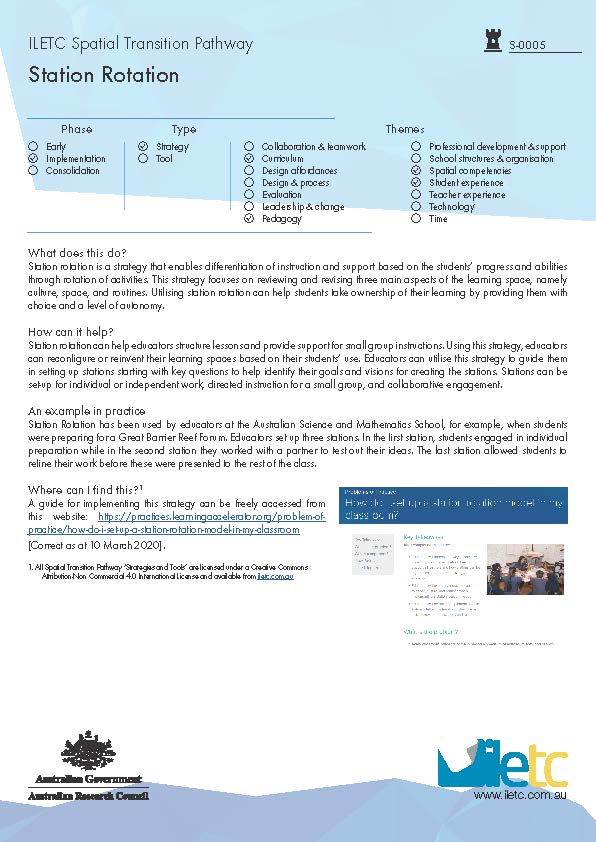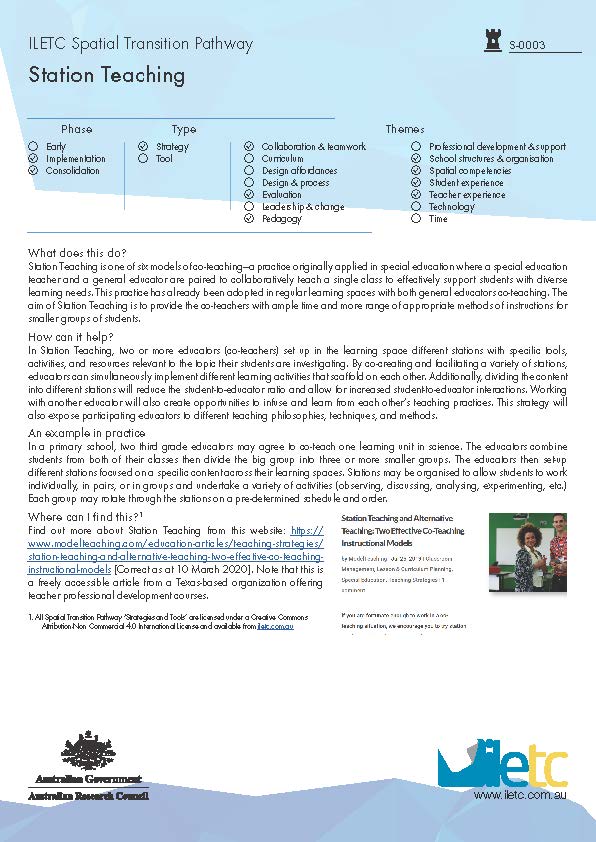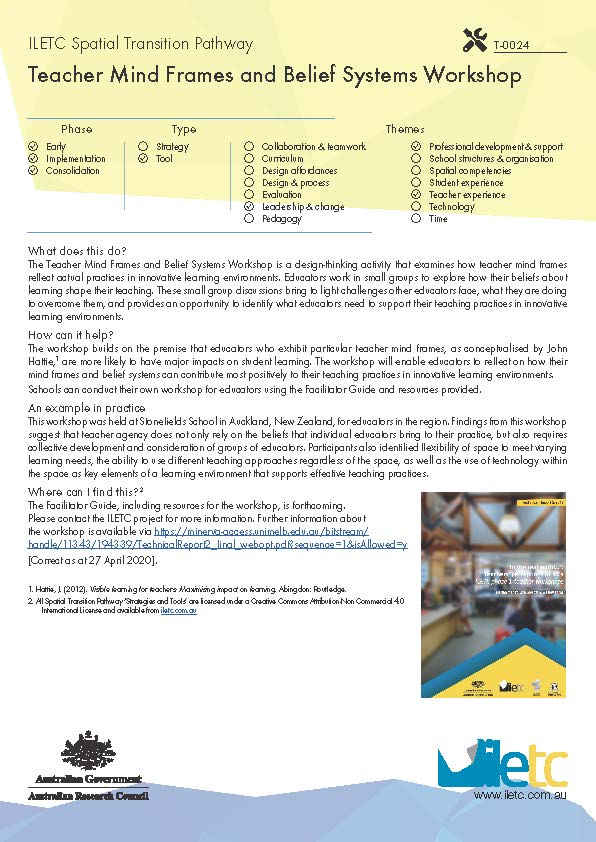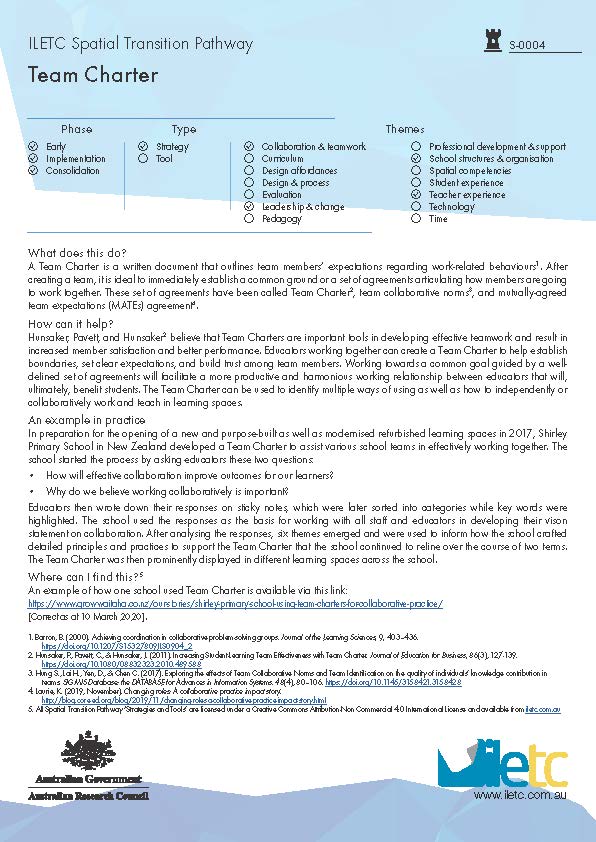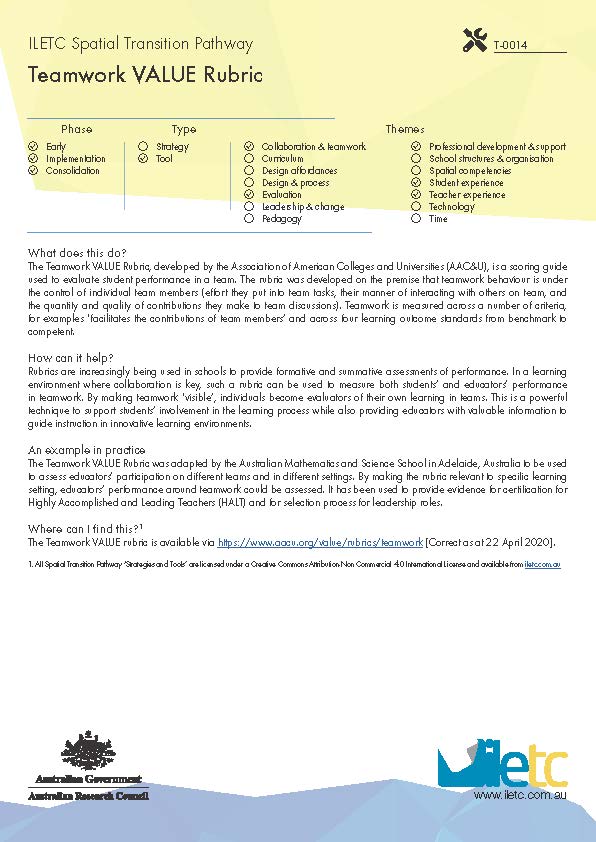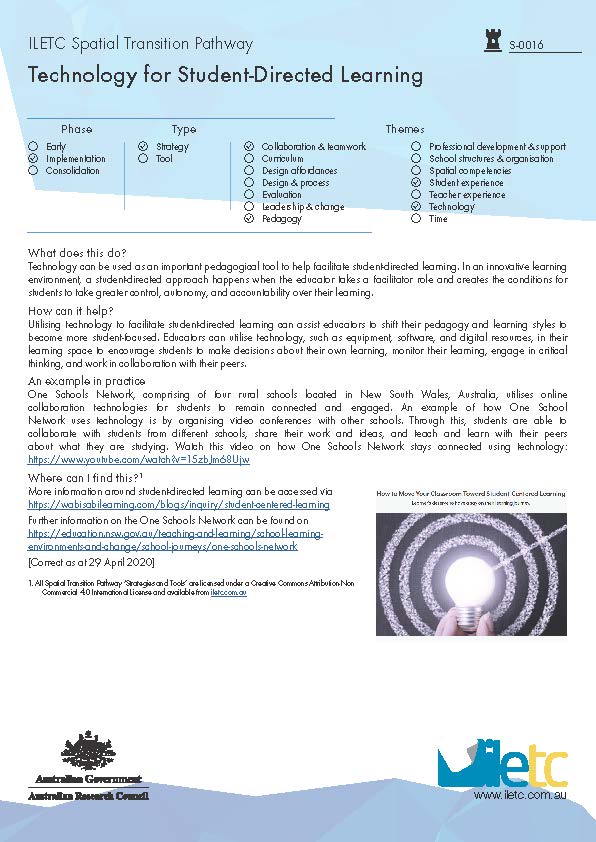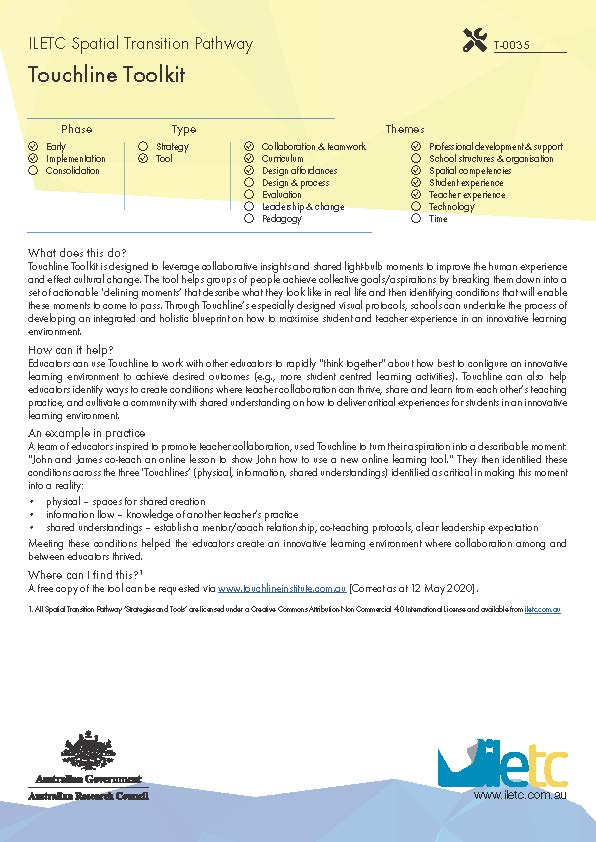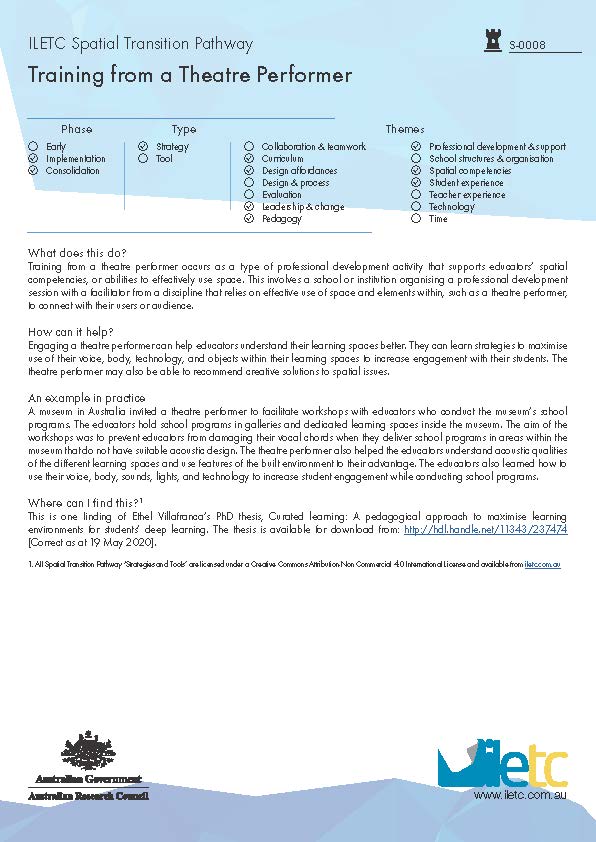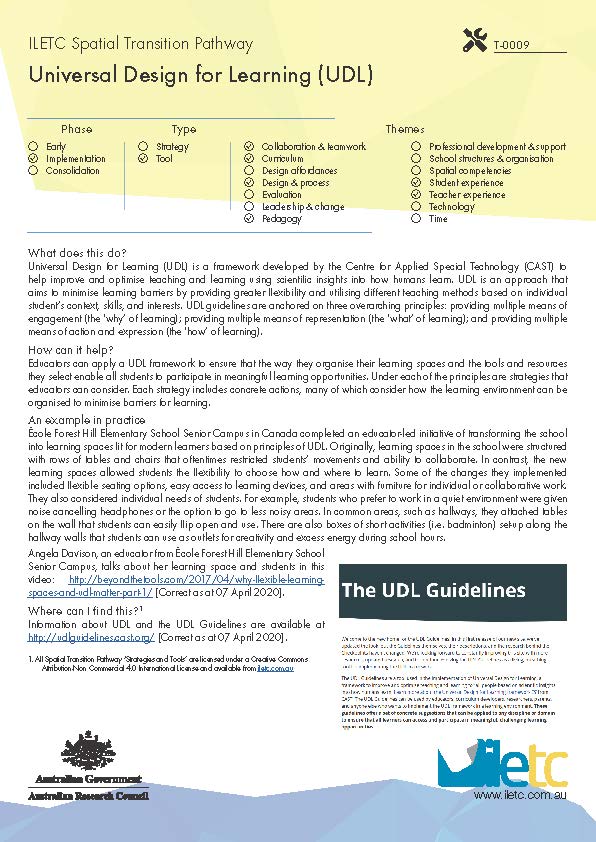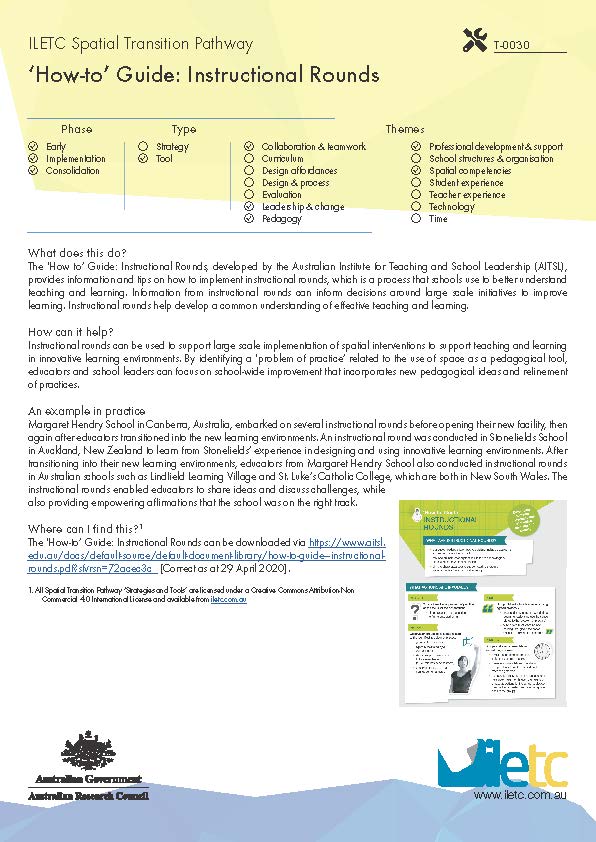| Introduction | Wayfinding activity | Spatial typologies | Spatial transition case studies | Spatial transition resources |
Spatial Transition Pathway
The Spatial Transition Pathway provides a framework for the strategies and tools which support teachers to make the journey of change into innovative learning environments. Strategy is defined as an explicit concept, theory or practice that enhances teachers’ use of innovative learning environments. A tool is an identifiable activity or protocol, that implements a strategy. You can use the database to search for strategies and tools by temporal phase or transition theme(s). If you would like to contribute a strategy or tool, please contact the ILETC team.
A Day in the life of a Student workshop is a design-thinking activity developed the DLR Group, an integrated design firm with offices across the globe, and adapted by the Innovative Learning Environment and Teacher Change project at the University of Melbourne, Australia. It involves educators creating a ‘map’ of how one student spends his/her day in school and a model of the learning environment based on a persona of that student. The workshop ends with a discussion of the ‘shape’ and affordances of the learning environment that impact students’ learning and experience.
Action research is a research methodology that can be helpful as educators look for ways to make changes in their learning environment and is also an important part of their professional development. It is characterised by a focus on research done by educators themselves, usually with a view to evaluate and improve their practice. Action research usually involves the identification of a problem, determining the needs or methods of data collection, collection and analysis of data, creation of an action plan, description of the use of the findings, creating a report as well as a future plan. The process is usually cyclical, and each step is vital in ensuring professionalism, completeness as well as validity of the action research.
The Archipelago of Possibilities is a strategy and professional development tool created specifically to help teachers and educators discover what they hold dear in their teaching practice. By using a travel metaphor, and designed like a board game, this tool will guide participants in reflecting on their practice, identifying what they consider as most important to have a successful teaching practice, examining what is holding them back from achieving their ideal, and developing steps to create a future, ideal teaching and learning space.
The Collaborative Teaching Practice professional learning courses developed by the New South Wales Government, Australia focus on how to develop and maintain collaborative teaching practices that enhance learning outcomes in innovative learning environments. The professional learning courses include a face-to-face introductory course (Introduction to Collaborative Teaching Practice), an online course focusing on establishing, building and maintaining collaborative relationships (Collaborative Teaching Practice), and an online course targeted towards educational leadership and school-wide collaboration (Leading Collaborative Teaching Practice).
Communities of Practice (CoP) are groups of people who share an interest and engage with each other about the same real-life problems or issues, and together learn more about the problem and from each other1. In the education context, CoPs may be formed by a group of educators who share their practice, support each other, learn from one another, and increase their skills together.
The innovative learning environment (ILE) matrix developed by Core Education provides a framework to guide educators on thinking around planning and implementing innovative approaches to support learning and teaching practices. The framework is divided into three areas for educators to focus on:
- Big ideas: exploring the big picture concepts of creating innovative learning environments
- Elements: different elements of innovative learning environments to consider
- Support dimensions: exploring the things that support effective innovative learning environments
The framework also outlines the progression of an innovative learning environment across the three areas. The phases include visioning, scoping, planning, implementing and sustaining.
Create the Perfect Play Space is a booklet developed by Child Inclusive Learning and Development Australia (Child Australia) for the Australian Government’s Inclusion and Professional Support Program. Child Australia is a not-for-profit organisation with a mission to improve well-being, learning, and development of children. The booklet provides low-cost suggestions for creating more engaging learning spaces, both indoor and outdoor. For educators in Australia, this booklet can support educators in using the Australian National Quality Framework (NQF) and the Early Years Learning Framework (EYLF).
Creating learning environment user personas is a strategy adapted from the technology industry and applied in education. Personas is a concept utilised in user-experience (UX) that represents a group of users who behave in similar ways in terms of products purchased, technology used, lifestyle choices, and customer service preferences. Personas are developed to better understand users of products and services. In the school context, schools and educators can develop a set of personas based on the students and educators who will occupy the space and then use these personas to evaluate the learning space.
Curated Site Tours are organised visits to other institutions that have innovative learning spaces. Visiting other sites allows educators to observe and examine how different institutions utilise and maximise the offerings of their learning spaces. These site tours may be organised by schools, districts, or professional organisations.
The Design Thinking for Educators Toolkit (DTET) contains an overview, methods, and instructions that will help readers put design thinking into action. The toolkit also includes a Designer’s Workbook to support design challenges and assist educators co-create solutions to context-specific problems. Design Thinking is a structured approach to generate and develop ideas. The creative process that is involved in a design thinking approach can help schools design meaningful solutions in learning spaces, within the school and community.
Differentiated learning is the idea that there are diverse learners who differ from one another in terms of their cognitive abilities, background knowledge and learning preferences. The understanding the range of ability levels and learning needs of students can be used by educators to create or adjust their learning spaces to more closely align with and accommodate the particular needs of a particular cohort of students.
Use of digital technology is a strategy that can support team teaching and collaboration. Collaboration happens when educators plan, teach, and work together to help support the needs of students in a learning space. There are commercially available programs specifically designed for educators. Free programs, with limited capabilities, are also available.
The EduTool: IEQ is a post occupancy evaluation tool designed to assess the indoor environment quality (IEQ) inside primary and middle school learning spaces, developed as part of the PhD research of Dr Philippa Soccio. IEQ refers to the quality of the environment within a specific built structure that impacts occupants’ health and well-being. EduTool: IEQ measures IEQ factors, such as acoustics, thermal comfort, air quality, and lighting, that have the greatest potential to impact effective teaching and learning.
Engaging in a change management process is a strategy that schools can adopt while transitioning from traditional to innovative learning environment. Change management is an approach to prepare, support, and help individuals, teams, and organisations in making organisational change. There are various change management models/frameworks that have been developed based on research and experience on how to best manage change within a school. These normally involve a sequence of steps or activities that move through the change process from inception to implementation to sustaining the change.
The Flexible Learning Space by Design professional learning courses developed by the New South Wales (NSW, Australia) Government focus on how innovative learning environments can be effectively designed to support learning and teaching practices. The professional learning courses explore how use of innovative learning environments can be supported by future-focused learning and teaching practices (Flexible Learning Space by Design), which are available online and face-to-face. Courses that are targeted towards teacher librarians who are redesigning their library spaces (Flexible Learning Space by Design for Teacher Librarians) are also available. Both courses can be delivered face-to-face or online.
The Future Classroom Toolkit is a collection of tools, guidance, and resources for designing learning scenarios that focus on advanced approaches to learning and teaching that support learners in the adoption of 21st century skills. The term “classroom” refers not just to a traditional classroom or innovative learning environment, but to any location where learning takes place, including home or other places outside of school. It comprises five toolsets, each of which can be used independently or as part of a complete process for developing learning scenarios. In each toolset there are a number of suggested activities that can be used in workshops aiming to design or adapt learning scenarios in schools. It also showcases case study videos of educators who have used the toolkit. The toolkit is built in the European context but has applicability to most education systems.
Get Active: Reimagining Learning Spaces for Student Success is a free online course co-developed by Microsoft and Steelcase Education to provide educators with an overview of the opportunities for reflection when reimagining active learning spaces for student success. The course involves watching a video and completing a set of activities published in a book by the International Society for Technology in Education with the support of Steelcase Education and Intel. Although written within a US context, this course provides information and strategies that are applicable in most education systems.
The Golden Circle is a concept for effective leadership popularised by Simon Sinek but also similar to Julia Atkin’s much earlier concept for enacting values and vision-driven development in schools. Both Atkins and Sinek use three concentric circles with ‘why’ in the centre, ‘how’ in the second, and ‘what’ in the outermost circle. These three questions guide the process of reflecting and crafting a shared vision that the organisation can collectively work towards.
This Guided Whole-School Reflection Activity, developed by the Victorian Department of Education, Australia, is designed to facilitate discussion to support continuous improvement of teaching and learning practices in schools. This activity is best conducted in alignment with the Annual Implementation Plan (AIP), which is designed to reflect on the past year, and to plan for the year ahead. The school’s self-evaluation against the Framework for Improving Student Outcomes (FISO) Continua of Practice, including evidence of impact of school improvement initiatives, supports the reflection activity. Although written within an Australian context, this tool provides information and activities that are applicable in most education systems.
Student voice refers to the expression of values, opinions, beliefs, and perspectives of individual and groups of students in a school about aspects of their educational experience that are based on choices, interests, passions, and ambitions. There are various research informed and experience-based models for incorporating student voice1 into educational experiences—ranging from students as limited partners, to equal student-teacher collaborative relationships to student-led initiatives. Student voice can also be incorporated at different stages of transitioning into new learning spaces—early, during the design of the learning space; implementation, as they transition into the new space; and consolidation, during which educators can use student voice to evaluate the user experience of the space and the learning that happens in it.
Indoor environment quality (IEQ) refers to the quality of the environment within a specific built structure that impacts its occupants’ health and well-being. Factors that impact IEQ include temperature, lighting, air quality, acoustics (sound), and relative humidity (RH). There are commercially available portable and/or digital sensors that measure these factors. Some devices measure a combination of these factors. There are even free smartphone and tablet apps that are able to do this albeit on a less accurate scale compared to dedicated devices.
An induction program is a process used by schools for new educators to introduce them to the school environment and prepare them for their role. The Innovative Induction Program for Teachers aims to provide support for new educators who are entering into an innovative learning environment for the first time by outlining resources that can be used to create effective learning spaces.
The Innovative Learning Environments and Teacher Practices Workshop is a design-thinking activity, which focuses on educators visualising the physical and experiential elements of the learning space. Working in groups, educators use craft materials to create elements of their learning space and organized these elements on a spectrum of emotions. The workshop ends with a discussion of possible solutions to challenges educators face while using these elements in their learning spaces.
The Innovative Learning environment Student Leanring Workshop is a design-thinking activity that examines educators’ understandings of deep learning of students. Educators work in small groups to explore the concept of student deep learning and model different scenarios where this type of learning takes place.
The Innovative Learning Environments Guide (Inclusion) is an information sheet that summarises New Zealand Ministry of Education’s set of five strategies for developing innovative learning environments that support all types of learners. It also provides four steps in understanding why pedagogy is integral to innovative learning environments that support inclusion. The sections contained within correspond with to specific pages within the Ministry’ website containing inclusive education guides.
The Journey Map is a design-thinking workshop that focuses on the journey educators go on when they transition into an innovative learning environment. Working in small groups, educators are involved in a ‘journey-map’ activity, which encourages peer discussion around their formative/early experiences, followed by individual reflections on what they did, felt, and thought when they transitioned into new learning spaces.
The Learning and Teaching in Innovative Learning Environments professional learning courses developed by the New South Wales Government, Australia focus on how educators and schools can develop learning and teaching practices in innovative learning environments. The courses include a face-to-face introductory course (Introduction to Learning and Teaching in Innovative Learning Environments), an online course focusing on effective teaching and learning practices in innovative learning environments (Learning and Teaching in Innovative Learning Environments), and an online course targeted towards educational leadership exploring the challenges and opportunities available when developing, implementing, and leading in, an innovative learning environment (Leading Learning and Teaching in Innovative Learning Environments).
The Learning Approach Questionnaire, developed by Biggs1 and adapted by Dan Murphy in the context of innovative learning environment, is a 16-item questionnaire that gauges the degree to which students employ deep and surface approaches to learning. Responses are given on a five-point Likert scale. The total (or average) scores to the eight items on each scale are a student’s deep and surface approach scores.
The Learning Furniture: A ‘Don’t Just Stuff It’ Guide is designed to highlight and respond to issues experienced by schools as they try to furnish new and existing learning spaces that support contemporary approaches to teaching and learning. The focus of this resource strategy is on furniture – an essential element of learning spaces in schools that can facilitate a variety of learning experiences.
The Learning Space Design Lab© is a workshop tool developed by Autens, an education consultancy based in Demark. The tool is designed to assist educators collaboratively design and redesign learning spaces based on how children learn. The tool supports educators to plan, prototype, and co-create their learning space.
The Learning Space Toolkit, developed by the New South Wales Government, provides educators with a range of strategies that can be used to transform learning and teaching practices in newly inhabited innovative learning environments.
The toolkit includes resources about:
- Building teacher capacity
- Identifying desired learning
- Examining current research
- Accessing existing examples
- Building a collective vision
- Mobilising technology
- Designing a learning space
- Planning to gather evidence
- Utilising the space
- Evaluating the impact
- Scaling and diffusing
Learning zones are distinct areas within a learning space that are used to differentiate between various forms of learning and teaching. Each learning zone can be categorised and defined based on the type of teaching and learning occurring in the area. Learning zones can be aligned with selected teaching approaches and inform decisions regarding use of technology and the learning space design.
Liberating Structures (LS) is a suite of 33 nonconventional ways of organising routine interactions of groups that work together. LS complement traditional practices, such as presentations, managed discussions, open discussions, status reports and brainstorm sessions. However, they are also designed to disrupt these more constraining approaches. It offers a way to foster lively participation and inclusion in groups regardless of size and across a variety of contexts.
The Linking Pedagogy, Technology and Space (LPTS) observational metric is a pre-programmed Excel spreadsheet that can be used to track and analyse the behaviour of educators and students in any learning space. Using a simple checkbox system, an observer will be able to record how much time an educator and their students spend on activities and behaviours associated with five domains (pedagogy; learning experiences; communities of learning; educator use of technology; and student use of technology). Whenever the observer sees a particular activity and/or behaviour, they simply click on the relevant checkbox, which then triggers a timer. When that activity and/or behaviour ends, the observer clicks on the box again to stop the timer. At the end of the observation, the observer can click on three buttons to calculate various activities and behaviours in each of the domains, and create bar graphs to visualise data collected. When used repeatedly over a period of time, it can help track changes in educator and student experiences in different learning spaces.
The Magical Mystery Change Contraption is a design-thinking workshop focused on examining the support educators require when undertaking changes in their learning spaces. The workshop involves educators visualising metaphors to help them describe the conditions in which changes in practice take place and describe the ideal system that would support them in adapting to an innovative learning environment.
The My Classroom Appraisal Protocol (MCAP) is a research survey instrument developed by Glen Earthman and Linda Lemaster1 to compare the attitude of teachers regarding the physical condition of their learning spaces. It consists of five sections (classroom assessment, attitudinal assessments, student learning, building assessment, and demographic data) with 48 items focused on various aspects of the building components and conditions (such as furniture, lighting, acoustics, thermal control, and equipment) plus an additional item on the teacher’s overall assessment of their building. The survey was originally used to compare responses of teachers from 22 secondary schools in the USA. In this study, the researchers found the physical environment strongly influenced teachers’ attitudes, which then affected their productivity and morale.
Peer observation is a strategy where educators observe each other’s practices and pedagogies to enable learning from one another and sharing of best practices. This strategy will also provide educators with opportunities to see how other educators use a space more effectively and innovatively as well as observe first-hand the impact of certain teaching practices on students.
Peer observation, feedback and reflection: A practical guide for teachers was developed by the Victorian Department of Education and Training, Australia to introduce school leaders, principals, and educators to peer observation as a strategy to enhance student learning. The guide includes advice on how to set-up conditions for successful peer observation and establish a school culture where peer observation becomes part of the norm. It also offers valuable techniques for peer observation and advice for both the educator being observed and the educator who is observing. Examples and links to additional resources are provided.
Project Zero’s Thinking Routines Toolbox, developed by Harvard University, makes extensive use of learning routines that are thinking rich. A routine can be thought of as any procedure, process, or pattern of action that is used repeatedly to manage and facilitate the accomplishment of specific goals or tasks. These routines are simple structures, for example a set of questions or a short sequence of steps, that can be used across various grade levels and content. What makes them routines, versus merely strategies, is that they get used over and over again in the learning space so that they become part of the learning culture. The routines become the ways in which students go about the process of learning and can be used in conjunction with particular learning space configurations.
Prototyping is a process whereby a prototype, or initial model, is created before the final design. A prototype can be used to gather feedback from the users of a proposed space, providing insight to inform the next phase of the design process.
Prototyping can be implemented using a four-stage model.
- Temporary installation
- More enduring (e.g. two spaces, two teachers)
- Soft prototype (relating to infrastructure, systems, timetables, team teaching, software, observations and feedback)
- Hard prototype (leads to a sense of ownership; needs right purpose, right people and right process)
Reflective practice is the ability to reflect on one’s actions so as to engage in a process of continuous learning. Educators who explore their own teaching through critical reflection develop changes in attitudes and awareness which can benefit their professional growth as well as improve the kind of support they provide their students.
Single Subject Research Design (SSRD) is a research methodology where the subject, an individual or a group (i.e. a class), is followed across a period of time. SSRD has been utilised in psychology, medicine, and education. After collecting baseline data, the individual or group is involved in a series of interventions, which may include prompts designed to change specific aspects of their practice. Interventions may occur across several time periods or various forms of interventions may occur in just one period. Post-intervention evaluations help to identify changes in practice, behaviour, or outcome and establish whether the interventions are effective or not
Station rotation is a strategy that enables differentiation of instruction and support based on the students’ progress and abilities through rotation of activities. This strategy focuses on reviewing and revising three main aspects of the learning space, namely culture, space, and routines. Utilising station rotation can help students take ownership of their learning by providing them with choice and a level of autonomy.
Station Teaching is one of six models of co-teaching—a practice originally applied in special education where a special education teacher and a general educator are paired to collaboratively teach a single class to effectively support students with diverse learning needs. This practice has already been adopted in regular learning spaces with both general educators co-teaching. The aim of Station Teaching is to provide the co-teachers with ample time and more range of appropriate methods of instructions for smaller groups of students.
The Teacher Mind Frames and Belief Systems Workshop is a design-thinking activity that examines how teacher mind frames reflect actual practices in innovative learning environments. Educators work in small groups to explore how their beliefs about learning shape their teaching. These small group discussions bring to light challenges other educators face, what they are doing to overcome them, and provides an opportunity to identify what educators need to support their teaching practices in innovative learning environments.
A Team Charter is a written document that outlines team members’ expectations regarding work-related behaviours1. After creating a team, it is ideal to immediately establish a common ground or a set of agreements articulating how members are going to work together. These set of agreements have been called Team Charter2, team collaborative norms3, and mutually-agreed team expectations (MATEs) agreement4.
The Teamwork VALUE Rubric, developed by the Association of American Colleges and Universities (AAC&U), is a scoring guide used to evaluate student performance in a team. The rubric was developed on the premise that teamwork behaviour is under the control of individual team members (effort they put into team tasks, their manner of interacting with others on team, and the quantity and quality of contributions they make to team discussions). Teamwork is measured across a number of criteria, for examples ‘facilitates the contributions of team members’ and across four learning outcome standards from benchmark to competent.
Technology can be used as an important pedagogical tool to help facilitate student-directed learning. In an innovative learning environment, a student-directed approach happens when the educator takes a facilitator role and creates the conditions for students to take greater control, autonomy, and accountability over their learning.
Touchline Toolkit is designed to leverage collaborative insights and shared light-bulb moments to improve the human experience and effect cultural change. The tool helps groups of people achieve collective goals/aspirations by breaking them down into a set of actionable ‘defining moments’ that describe what they look like in real life and then identifying conditions that will enable these moments to come to pass. Through Touchline’s especially designed visual protocols, schools can undertake the process of developing an integrated and holistic blueprint on how to maximise student and teacher experience in an innovative learning environment.
Training from a theatre performer occurs as a type of professional development activity that supports educators’ spatial competencies, or abilities to effectively use space. This involves a school or institution organising a professional development session with a facilitator from a discipline that relies on effective use of space and elements within, such as a theatre performer, to connect with their users or audience.
Universal Design for Learning (UDL) is a framework developed by the Centre for Applied Special Technology (CAST) to help improve and optimise teaching and learning using scientific insights into how humans learn. UDL is an approach that aims to minimise learning barriers by providing greater flexibility and utilising different teaching methods based on individual student’s context, skills, and interests. UDL guidelines are anchored on three overarching principles: providing multiple means of engagement (the ‘why’ of learning); providing multiple means of representation (the ‘what’ of learning); and providing multiple means of action and expression (the ‘how’ of learning).
The ‘How to’ Guide: Instructional Rounds, developed by the Australian Institute for Teaching and School Leadership (AITSL), provides information and tips on how to implement instructional rounds, which is a process that schools use to better understand teaching and learning. Information from instructional rounds can inform decisions around large scale initiatives to improve learning. Instructional rounds help develop a common understanding of effective teaching and learning.

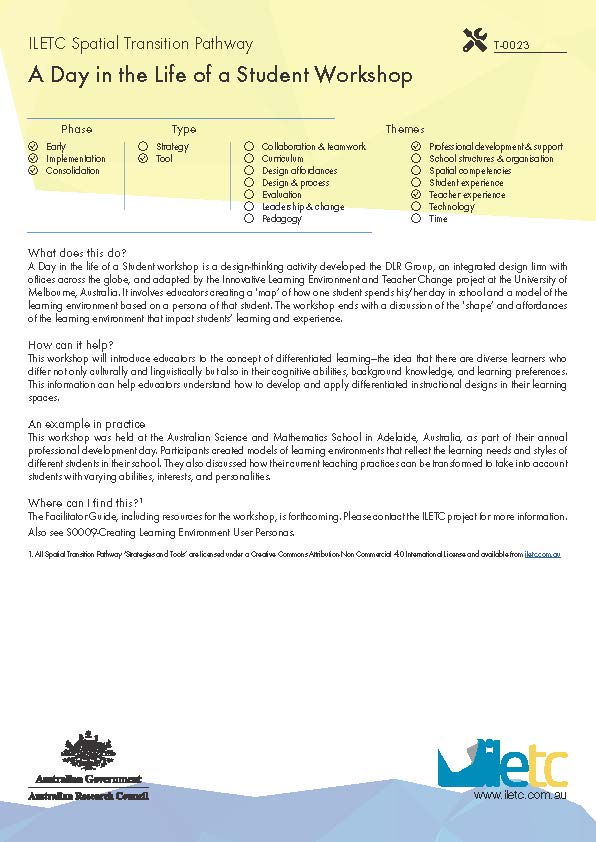
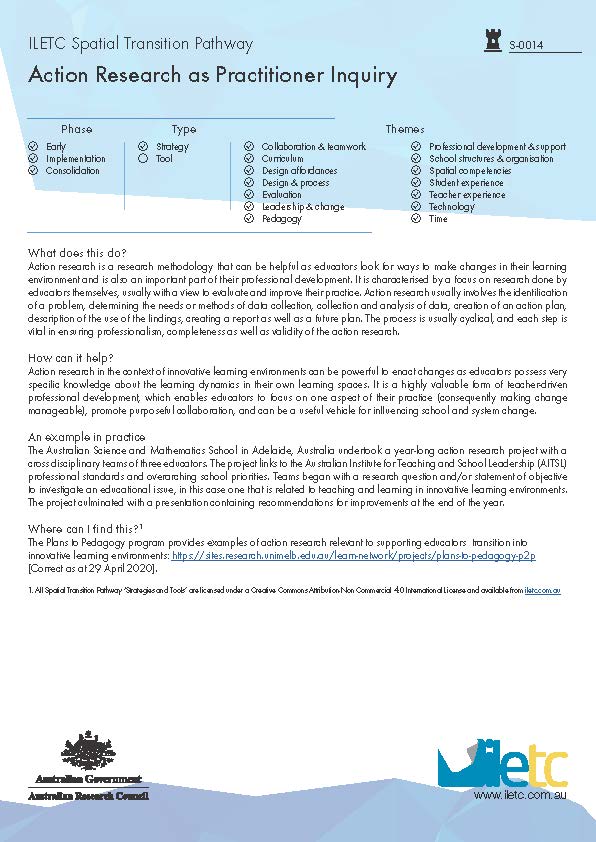
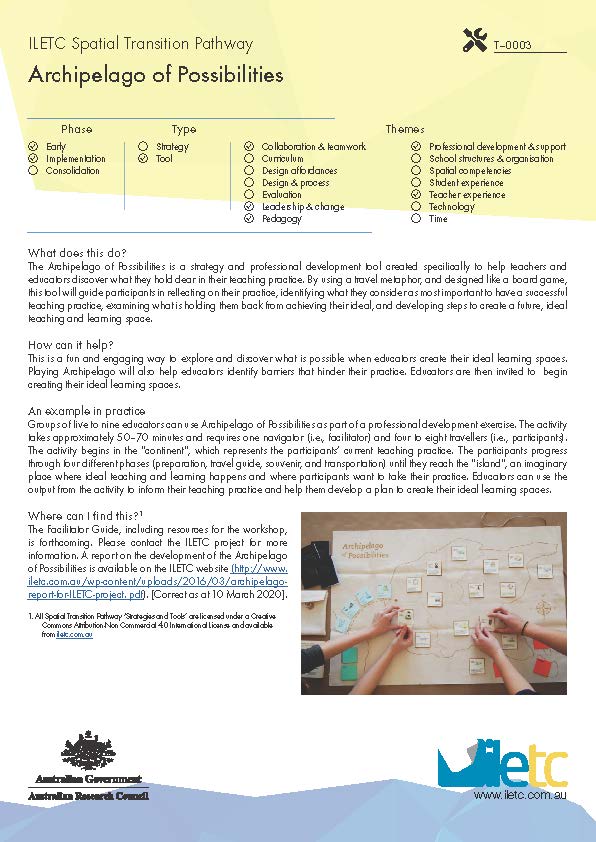
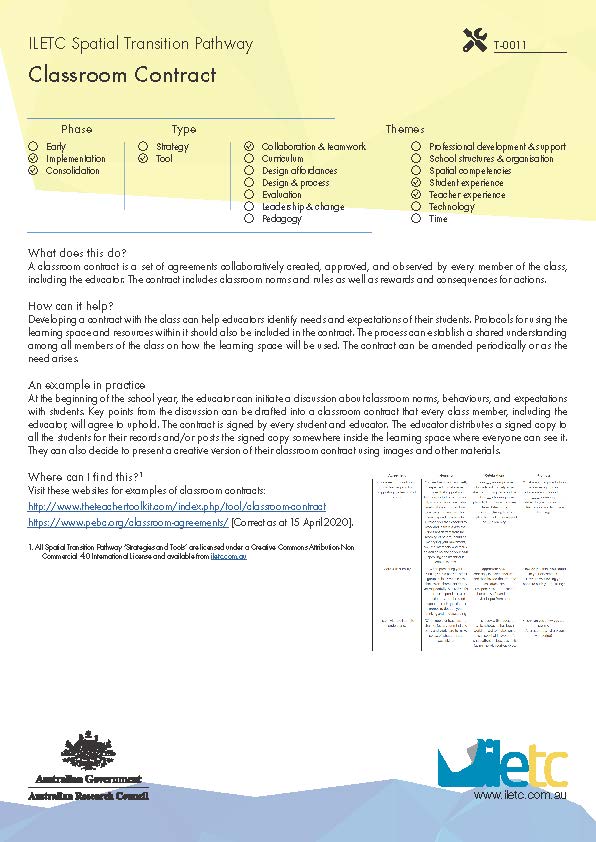
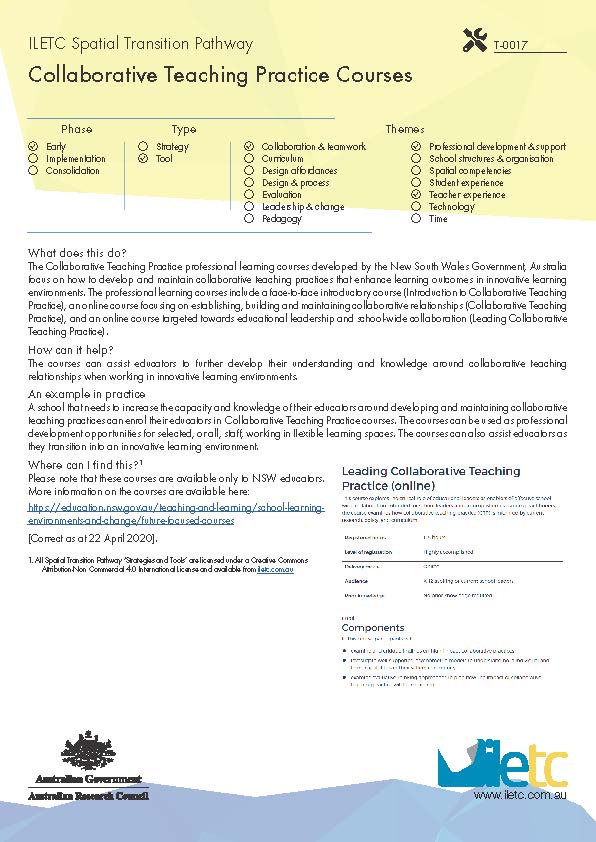
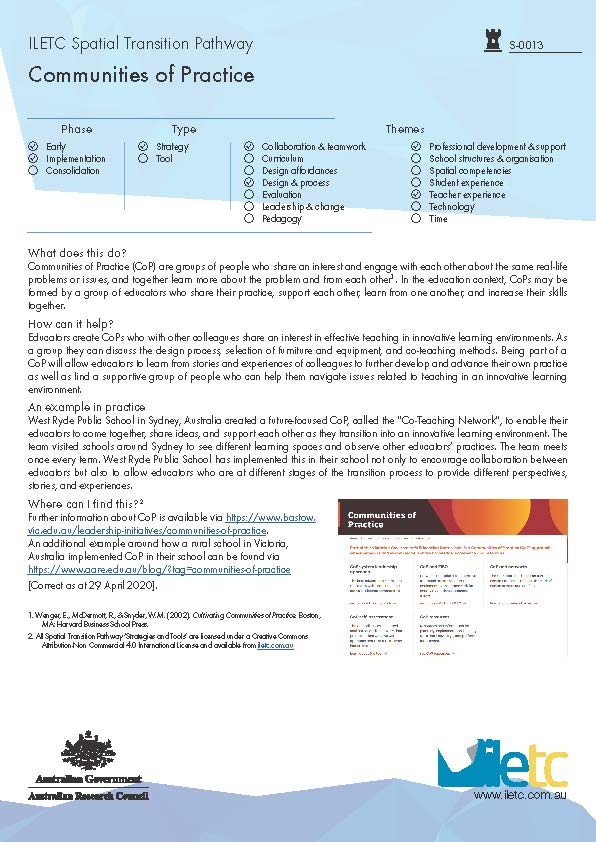
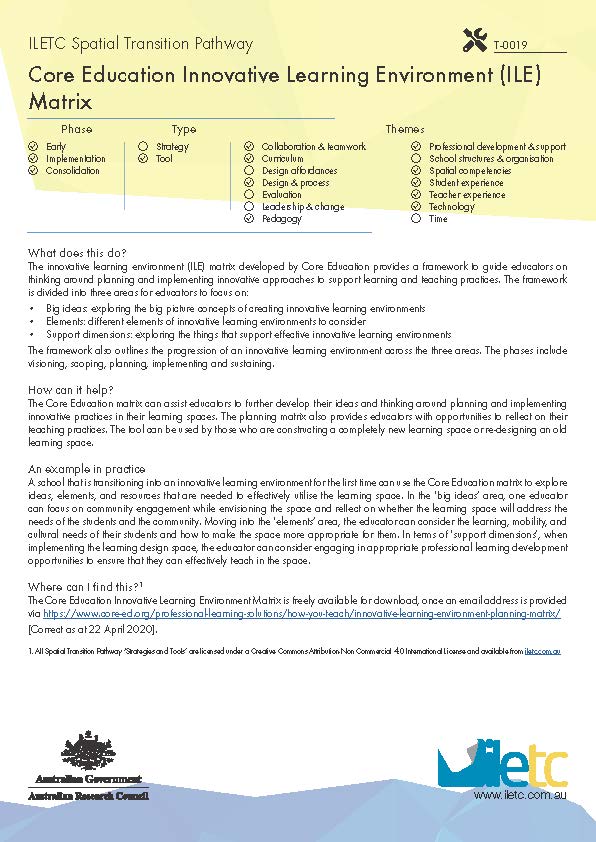
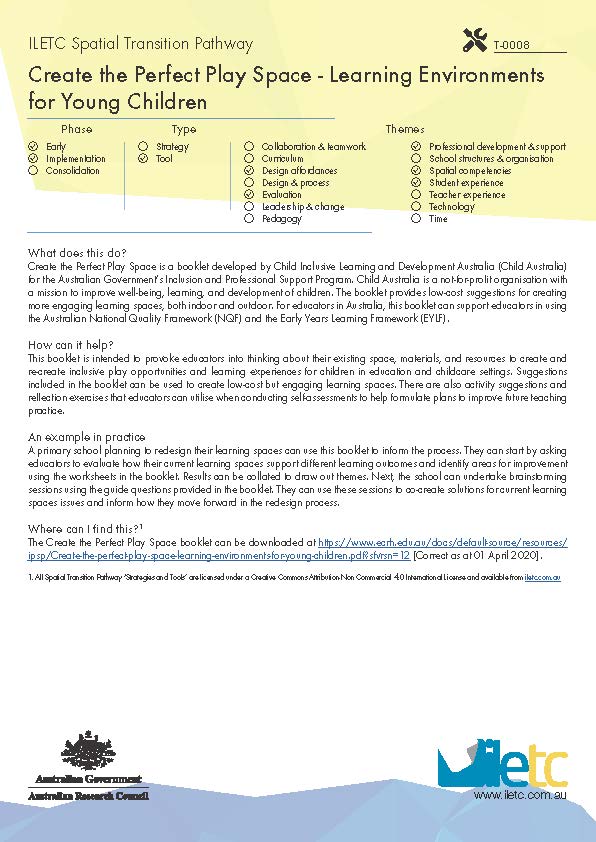
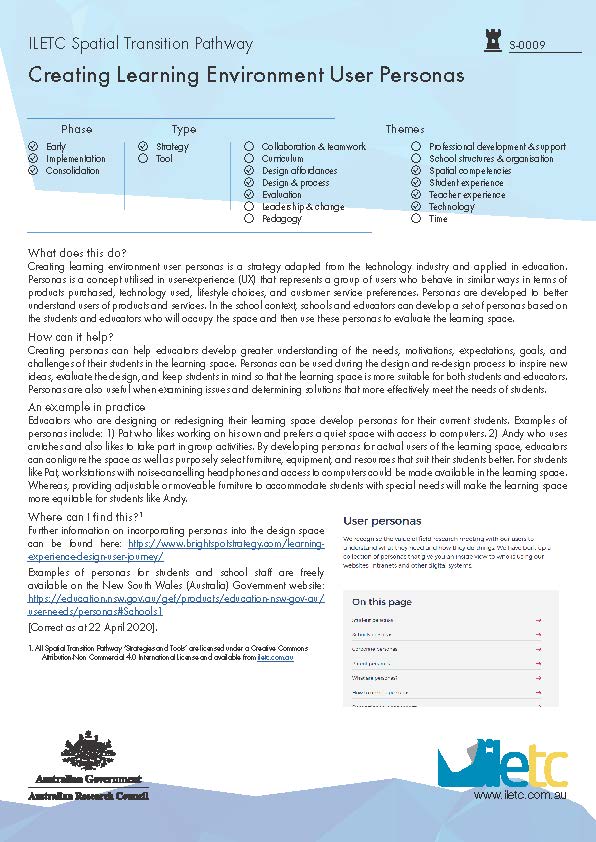
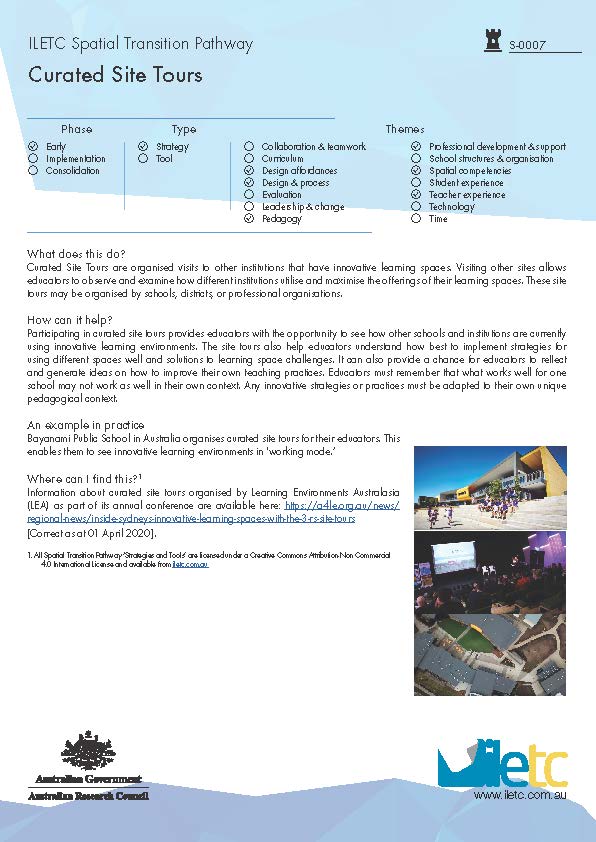
![Design Thinking for Educator’s Toolkit [DTET]-image](http://www.iletc.com.au/wp-content/uploads/2020/05/T0004.jpg)
